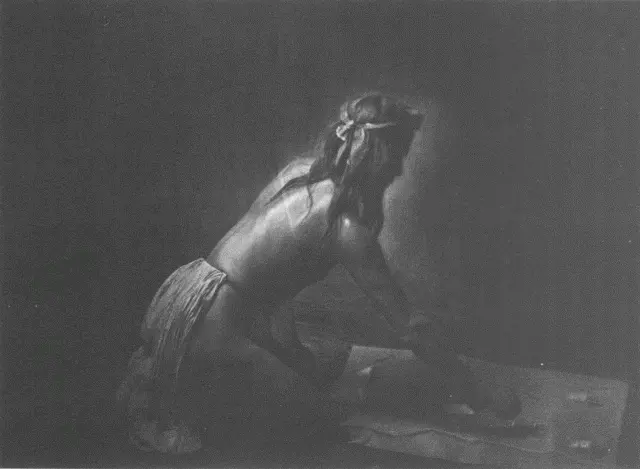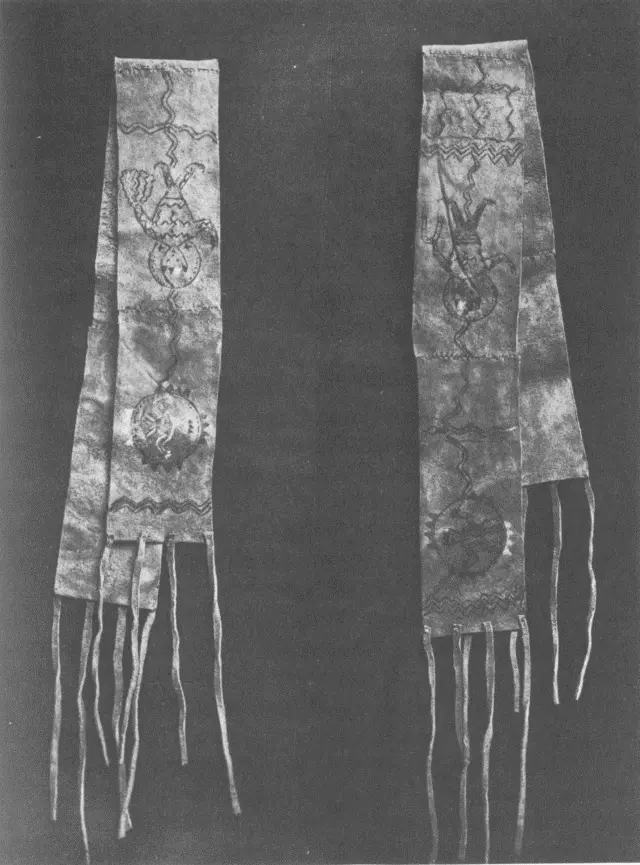3—Yólkai Nalí̆n, described above.
4—Yakósha Skhĭn, God of Moisture and also Controller of Rain. Since snow, ice, hail, frost, dew, and fog are derived from the clouds, Yakósha Skhĭn is sometimes termed Chief of the Clouds, but in general the clouds are regarded as his workshop, for there is another who has direct charge and control of them.
P, Q, R, and S—These figures represent gods, or, in Apache, gáŭn, who are supposed to have been made by the Sun for the purpose of curing people stricken with bodily disease. Diseases of the body are regarded as distinct from those of the mind. The gáŭn live in the four cardinal directions and are impersonated in medicine ceremonies by men wearing stick masks, who always take stations at the four sides of the patient. These doctors are not called in case of illness until after the four chief deities have been supplicated, when, as a last resort, the medicine-man prays to the gáŭn. If the gáŭn cannot help, there is believed to be no hope for the patient. In ancient times all animals could talk, and many were used as beasts of burden. The bear and the deer were the horses of that time. In the graphic representations of the Apache these four spirits are often pictured riding deer and bear.
Medicine and Medicine-Men
Table of Contents
The medicine-men of the Apache are most influential personages. They are usually men of more than ordinary ability, claiming, through their many deities and their knowledge of the occult and ominous, to have supernatural power. In sickness any individual may make supplication to the deities, but the prayers of the medicine-men are accepted as being most efficacious.

Apache Medicine-man
Many of the medicine-men have some knowledge of the medicinal properties of plants and generally make use of them in the treatment of disease, but their treatment consists more of incantation than aught else. Even in collecting the plants they invoke the deities, usually facing the cardinal points in turn. In case the prescription calls for a combination of herbs or other vegetal products, the number four is always strictly adhered to; it might be a decoction made of four roots of one variety or of a single root from each of four varieties of plants.
Every Apache medicine-man has a medicine skin, his ĕpú̆n ezchí, inscribed with the symbolism of the tribal mythology. With his prayer wands he rehearses the symbolic figures, praying to the mythical characters who are regarded as most efficacious in the particular ailment under treatment. In his own little kówa, or dwelling, with the painted deerskin spread before him, on which are delineated the symbolic representations of a score of gods comprising the Apache pantheon, a medicine-man will sit and croon songs and pray all day and all night in the hope of hearing the voices of celestial messengers.
Many of the prayers and songs of the Apache medicine-men are very beautiful. The following is an example:
1 Stĕná pĕhí̆nda nzhóni, tógonĭl ádahĕ bé̆oĭshkan.
2 Inaté̆sh nzhóni bé̆oĭshkan.
3 Ĕnŭdé̆tsos nzhóni bé̆oĭshkan.
4 Ĭnyátĭl nzhóni bé̆oĭshkan.
5 Bé̆hnandahĭ ĭnkéhĭ tógonĭl ádahĕ bé̆oĭshkan.
6 Ĭndú̆h bĭnandáhĕ bé̆oĭshkan.
7 Bĕh nashálolĕzh ndĕ; nashéyo shĭchí̃sĭgon zhóndolĕzh.
8 Ndĕ shĭnklóho bĕh sanandáhĕ bé̆oĭshkan.
9 Bĕh sanashádo bé̆oĭshkan.
10 No oskóngo adĭshní daházhĭ bĕhnashádo ti ndĕ ta nashéyo gonzhódo.
11 Shágocho paógo násha.
12 Akúd ndĕ sa nzhóni yé̆sĭtchĭ yé̆atido.
13 Pídi yú̆gga sa nzhóni yé̆kĭssĭn shí̃dĭl é̆ndo.
14 Shĭtú̆h gozhóndolĕzh pógo hádĭshndi.
1 Stĕnátlĭhăn, you are good, I pray for a long life.
2 I pray for your good looks.
3 I pray for good breath.
4 I pray for good speech.
5 I pray for feet like yours to carry me through a long life.
6 I pray for a life like yours.
7 I walk with people; ahead of me all is well.
8 I pray for people to smile as long as I live.
9 I pray to live long.
10 I pray, I say, for a long life to live with you where the good people are.
11 I live in poverty.
12 I wish the people there to speak of goodness and to talk to me.
13 I wish you to divide your good things with me, as a brother.
14 Ahead of me is goodness, lead me on.
While this prayer is worded as if uttered by the supplicant, it is in reality offered by the medicine-man in his behalf.
There are head medicine-men and medicine-men of lesser degree. The man who becomes influential enough to be considered the head medicine-man of the tribe is more of a politician than a doctor of diseases, and in important cases only is he called to treat in a healing ceremony. It requires a particularly capable Indian to attain the position of head medicine-man, for to do so he must not only make the people subservient to his will, but must wrest the leadership from some other and usually older medicine-man who is himself an influential character. Unfortunately it is apt to be the most crafty, scheming man who gains such power over his tribesmen.
A case in point was the recent strife between Das Lan and Goshonné. For some years the latter, an Indian of exceptional ability and withal apparently an honest man in his treatment of diseases, was the head medicine-man of the White Mountain Apache. Then it came to pass that the crafty old Das Lan of the Cibicu had his vision, in which was revealed a special message brought by Chuganaái Skhĭn from Kútĕrastan to the Apache people. This was the beginning of the present so-called messiah craze.

Maternity Belt - Apache
From the first there was promise of a battle to the end between Goshonné and Das Lan. Goshonné well knew that if the new cult gained a firm footing he would lose his influence and at best be but a mediocre medicine-man. Das Lan, on the other hand, knew that he must break the power of such a man as Goshonné, if he was to assume the leadership. Goshonné scoffed and scorned, and would have none of the new belief. Still, he was an Indian, and the prophecies of his rival gradually filled him with superstitious fear, while his followers were either deserting him openly or were secretly joining the ranks of the enemy. Death was predicted for the members of Goshonné's own family, and well could Das Lan make such prophecies, for Goshonné's two brothers were already stricken with tuberculosis. First one died, then the other. Das Lan could now point to him and say, "That is what Kútĕrastan does to those who do not believe!" It was thus that Goshonné's power finally was broken and Das Lan became a seer.
Sacred pollen, hádĭntĭn, is used in all ceremonies, particularly in those designed for healing. The principal source of hádĭntĭn is the tule, but much of it comes from the piñon. For prayers invoking an abundance of corn, pollen is mixed with cornmeal. Not only do the medicine-men use this powder, but each individual carries a small quantity of it in a deerskin pouch somewhere about his person. In the pollen may be small medicine trinkets—sometimes consisting of a few shell beads from prehistoric ruins—and there is scarcely a person, old or young, who does not have a small section of the candle cactus fastened somewhere about his clothing.
When childbirth approaches, the medicine-men are always summoned. Nothing can give a better idea of the medicine rites on such an occasion, and of the use of sacred pollen, than a description of a maternity belt procured by the writer and here illustrated. So far as can be learned, this belt is very old, so old that its painted symbolic figures have been three times renewed. Belts of this kind are very rare, and are hired whenever their use is required. The owner of this particular belt, a widow, did not care to dispose of it; as she expressed it, "it is like a husband": the remuneration from granting its use was sufficient to support her.
Читать дальше














